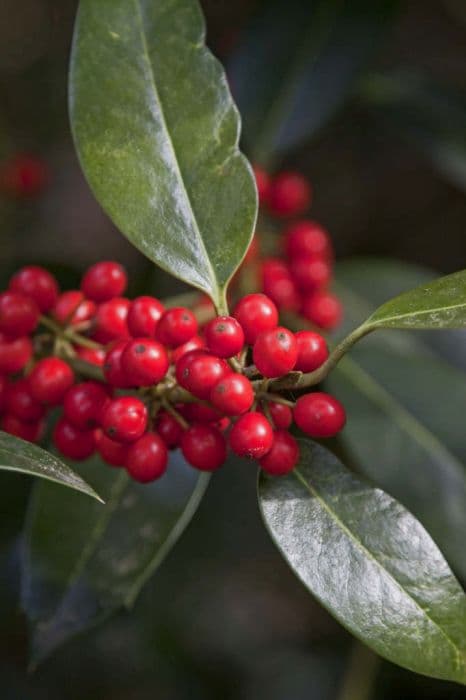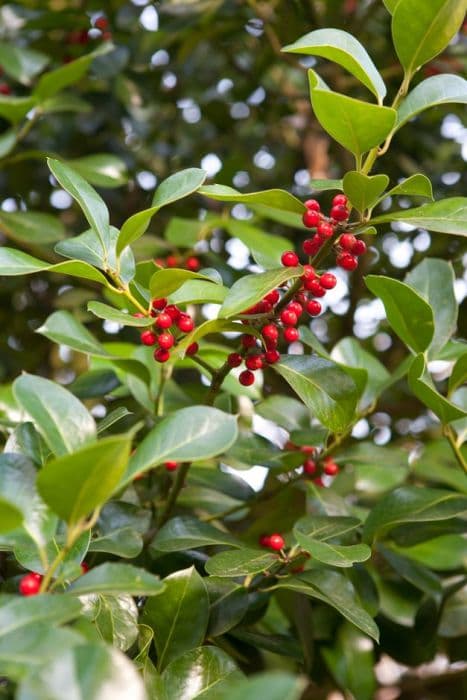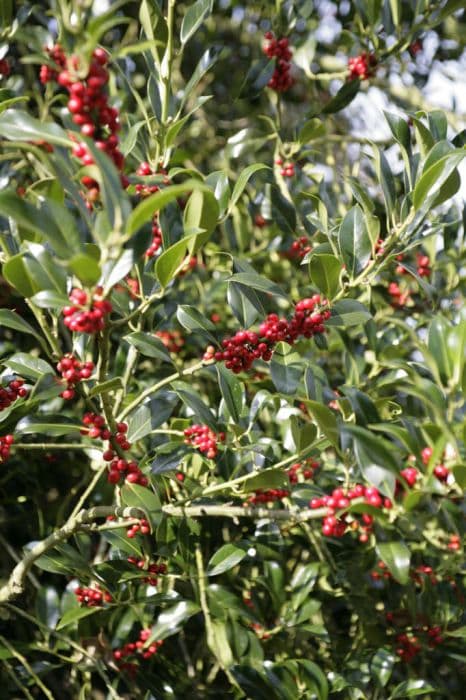English Holly Ilex aquifolium 'Madame Briot' (f/v)

ABOUT
Ilex aquifolium 'Madame Briot', commonly known as English Holly, is an ornamental plant notable for its variegated leaves and bright red berries. The glossy leaves are dark green with a distinctive spiny margin and are irregularly edged with a striking yellow border, adding a splash of color to the foliage. This variegation can give the plant a lighter overall appearance, especially when viewed from a distance. The leaves are typically about two to three inches long with a leathery texture that adds to its robust appearance. The English Holly is also well-known for its beautiful berries, which are typically a rich red, providing a vibrant contrast to the variegated leaves. These berries are a highlight on the plant, especially during the fall and winter months, when they are most abundant. They are small and rounded, often clustered near the base of the leaves, adding to the plant's decorative appeal. In spring, the plant may produce small, white flowers that are inconspicuous compared to the bold leaves and berries. These flowers can attract pollinators, adding a subtle and natural charm to the plant's appearance. The overall impression of Ilex aquifolium 'Madame Briot' is one of classic beauty with its striking foliage and cheerful berries, making it a popular choice for gardens seeking year-round interest.
About this plant
 Names
NamesFamily
Aquifoliaceae.
Synonyms
English Holly, Common Holly, European Holly, Christmas Holly.
Common names
Ilex aquifolium 'Madame Briot'
 Toxicity
ToxicityTo humans
Commonly known as English holly, Ilex aquifolium 'Madame Briot' is considered to be toxic to humans if ingested. The berries contain saponins and theobromine, substances that can cause symptoms such as nausea, vomiting, diarrhea, and abdominal pain. In severe cases, ingestion may lead to drowsiness, dehydration, and, rarely, seizures. The leaves might also cause minor symptoms if eaten due to their spiny nature which can cause physical irritation to the mouth and throat.
To pets
English holly is also toxic to pets, specifically cats and dogs. Similar to its effects on humans, ingestion of the berries can cause gastrointestinal upset in pets, with symptoms that may include vomiting, diarrhea, and abdominal pain. The leaves, with their prickly edges, can also cause physical irritation to the mouth and gastrointestinal tract. Depending on the amount ingested, there could be more severe symptoms, but typically ingestion of small quantities leads to mild to moderate symptoms.
 Characteristics
CharacteristicsLife cycle
Perennials
Foliage type
Evergreen
Color of leaves
Variegated
Flower color
White
Height
6-10 feet (1.8-3 meters)
Spread
6-10 feet (1.8-3 meters)
Plant type
Shrub
Hardiness zones
5-9
Native area
Europe
Benefits
 General Benefits
General Benefits- Ornamental Value: Ilex aquifolium 'Madame Briot' - commonly known as English Holly - is valued for its glossy, variegated leaves and bright red berries that provide a splash of color in gardens, particularly during the winter months when other plants may be dormant.
- Wildlife Habitat: English Holly offers shelter and food for birds and other wildlife, especially in winter when other resources are scarce.
- Drought Resistance: Once established, English Holly can tolerate periods of drought, making it suitable for gardens with dryer conditions.
- Screening Plant: With its dense growth habit, English Holly can be used as a hedge or screen for privacy or to block unsightly views.
- Adaptability: English Holly can adapt to a range of soil types, though it prefers well-drained, acidic soils.
- Low Maintenance: Requiring minimal pruning and care once established, English Holly is a low-maintenance option for landscapers and gardeners.
- Seasonal Interest: Its evergreen nature ensures year-round interest in the landscape, adding structure and color even in the winter months.
- Pollinator Friendly: Although it's dioecious, with separate male and female plants, the female plants produce flowers that can attract bees and other pollinators.
- Cultural Significance: English Holly is associated with Christmas and winter holidays, making it an important plant for cultural and festive decorations.
- Versatility: It can be trained into different shapes and sizes, making it versatile for various landscape designs, from topiaries to natural hedges.
 Medical Properties
Medical PropertiesThis plant is not used for medical purposes.
 Air-purifying Qualities
Air-purifying QualitiesThis plant is not specifically known for air purifying qualities.
 Other Uses
Other Uses- Ilex aquifolium 'Madame Briot', commonly known as English Holly, can be used for topiary, as their dense growth habit allows them to be shaped into various structured forms for garden aesthetics.
- English Holly branches with their bright red berries are traditionally used in winter holiday decorations and wreath-making, contributing to festive decor.
- The wood of the English Holly is often used for inlay work in fine furniture due to its white color and fine grain, which contrasts well with darker woods.
- English Holly can be planted as part of a hedge or boundary, providing privacy and acting as a windbreak in residential gardens.
- Its spiny leaves make it a good deterrent plant for security purposes, often planted beneath windows to discourage intruders.
- The shrub can serve as a host plant for various species of birds, offering shelter and berries as a food source during harsh winter months.
- The dense foliage of English Holly provides excellent nesting sites for birds, promoting biodiversity in a garden setting.
- English Holly wood is sometimes used to make chess pieces, particularly the white pieces, due to its fine, pale finish after polishing.
- The plant can be used for educational purposes, demonstrating pruning techniques and garden management to horticulture students.
- In photography and film, English Holly is often used as a backdrop or decorative element to convey a traditional or seasonal setting.
Interesting Facts
 Feng Shui
Feng ShuiThe English Holly is not used in Feng Shui practice.
 Zodiac Sign Compitability
Zodiac Sign CompitabilityThe English Holly is not used in astrology practice.
 Plant Symbolism
Plant Symbolism- Protection and safety: Hollies, including 'Madame Briot,' often symbolize protection due to their spiky leaves, which are thought to ward off negative energy or evil spirits.
- Everlasting life: As an evergreen plant, hollies represent immortality and everlasting life, maintaining their green foliage throughout the year, even in harsh winter conditions.
- Fertility and rebirth: With their vibrant red berries, holly plants are often associated with fertility and the promise of new life, especially in pagan traditions where they were celebrated during the winter solstice.
- Good luck: Holly is viewed as a plant that brings good fortune and luck, going back to Druidic beliefs that holly was a sacred plant that would bring protection and luck to their homes.
- Hope: The holly plant is also a symbol of hope, with its resilience during the winter months being a reminder that life continues and spring will return.
 Water
WaterEnglish Holly 'Madame Briot' prefers consistently moist soil without being waterlogged. A watering schedule of once per week with approximately 1 to 1.5 gallons of water for younger plants is ideal, while established plants are more drought-tolerant. During spring and summer, you may need to water more frequently, especially if the weather is particularly dry or hot. Reduce watering in the winter when the plant is not actively growing. Always check that the top inch of soil is dry before adding more water to prevent overwatering.
 Light
LightEnglish Holly 'Madame Briot' thrives in both full sun and partial shade. The best spot for the plant would provide it with at least 4 to 6 hours of direct sunlight per day. However, it can also tolerate more shaded areas, which makes it quite versatile in different garden settings.
 Temperature
TemperatureEnglish Holly 'Madame Briot' is hardy and can withstand temperatures as low as 5°F and as high as 90°F, but it prefers a comfortable range between 50°F to 70°F. To ensure robust growth, protecting the plant from extreme cold and heat is advisable, as it performs best under moderate temperature conditions.
 Pruning
PruningPrune English Holly 'Madame Briot' to shape it, control its size, and encourage new growth. The best time for pruning is in the late winter or early spring before new growth begins. This holly can also be pruned in late summer if necessary. It's generally recommended to prune no more than one-third of the plant at a time to prevent stress.
 Cleaning
CleaningAs needed
 Soil
SoilEnglish Holly 'Madame Briot' thrives best in well-draining, loamy soil enriched with organic matter, with a slightly acidic to neutral pH between 5.5 and 7.0. A mixture of peat, pine bark, and either sand or perlite will create optimal conditions for growth.
 Repotting
RepottingEnglish Holly 'Madame Briot' should be repotted every 2-3 years or when it becomes root-bound. In larger landscape settings, instead of repotting, refresh the surrounding soil periodically to ensure nutrient availability.
 Humidity & Misting
Humidity & MistingEnglish Holly 'Madame Briot' does well in average humidity conditions typical of outdoor environments. While it can tolerate a range of humidity levels, moderate humidity is best, without the need for special humidity adjustments.
 Suitable locations
Suitable locationsIndoor
Place in bright, indirect light and keep away from dry heat sources.
Outdoor
Plant in partial shade to full sun, shelter from strong winds.
Hardiness zone
6-9 USDA
 Life cycle
Life cycleIlex aquifolium 'Madame Briot', commonly known as English holly, begins its life cycle as a seed, typically requiring a period of cold stratification to break dormancy and germinate. Upon sprouting, the seedling grows into a juvenile plant with simple leaves, differing from the spiny mature leaves, a phase that can last for several years. As it matures, the holly develops its characteristic dark green, spiny leaves and begins to form the small white flowers that are dioecious, meaning male and female flowers are on separate plants. Following pollination by insects, female plants produce the iconic red berries, which are an important food source for birds in winter and also aid in seed dispersal. Holly trees can take several years to reach reproductive maturity and can live for numerous decades, growing slowly and developing a dense, conical to pyramidal shape. English holly can also be vegetatively propagated through cuttings, bypassing the seed stage for quicker maturation.
 Propogation
PropogationPropogation time
Spring-Early Summer
The most popular method to propagate Ilex aquifolium 'Madame Briot' also known as English Holly, is through semi-hardwood cuttings. This process is typically done in late summer. Healthy, disease-free branches are selected, and cuttings of about 6 to 8 inches (15 to 20 centimeters) in length are taken. The leaves on the lower half of the cutting are removed, and the cut end is treated with rooting hormone to encourage root development. The prepared cuttings are then inserted into a pot with well-draining soil. The pot is kept in a warm location with high humidity and indirect light until rooting occurs, which can take several weeks to a few months. After roots have established, the new plants can be transplanted to their final location.









